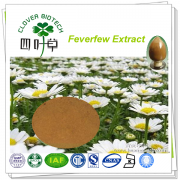
1. Parthenolide 0.3%, 0.8% HPLC
2. Offwhite to white powder
3. GMP, Kosher, Halal, ISO
4. Free sample
5. Large output
Latin name: Tanacetum Parthenium
Active Ingredient: Parthenolide
Specification: 0.3%, 0.5% ;0.8%
Appearence: Brownish yellow powder
Part of used: Flower
Molecular Formula: C15H20O3
Molecular Weight: 248.32
Feverfew (Tanacetum parthenium) is a traditional medicinal herb which is found in many old gardens, and is also occasionally grown for ornament.
The plant grows into a small bush up to around 46 cm (18 in) high with citrus-scented leaves, and is covered by flowers reminiscent of daisies. It spreads rapidly,
and they will cover a wide area after a few years. It is also commonly seen in the literature by its synonyms, Chrysanthemum parthenium (L.) Bernh. andPyrethrum parthenium (L.) Sm.
Feverfew was native to Eurasia; specifically the Balkan Peninsula, Anatolia and the Caucasus, but cultivation has spread it around the world and it is now also found in Europe, the Mediterranean, North America and Chile.
Though its earliest medicinal use is unknown, it was documented in the first century (AD) as an anti-inflammatory by the Greek herbalist physician Dioscorides.
Feverfew is a perennial herb, which should be planted in full sun, 38–46 cm (15–18 in) apart and grows up to 61 cm (24 in) tall. It is hardy to USDA zone 5 (−30 °C (−22 °F)) and should be cut back to the ground in the autumn. Outside of its native range it can become an invasive weed.
What is Parthenolide?
Parthenolide is a sesquiterpene lactone of the germacranolide class which occurs naturally in the plant feverfew (Tanacetum parthenium), after which it is named. It is found in highest concentration in the flowers and fruit.
Feverfew is used in herbalism and is purportedly useful for a variety of ailments. Many vendors of feverfew remedies specify the content of parthenolide in their products,
because it is believed to be the primary chemical constituent responsible for biological activity.
Lack of solubility in water and bioavailability limits the potential of parthenolide as a drug. Drug researchers are trying to develop synthetic analogs instead that will be absorbed to a more useful extent.
Where will Parthenolide be used for?
· Powful anti-cancer effect.
· Cure migraine headaches and Rheumatic inflammatory
· Used as carminative
· Applied as emmenagogue and insecticide
· Relieve renal pain and vomit
· Cure cold and fever